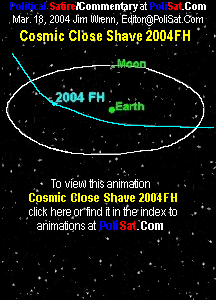Mar. 18, 2004 : Poli
Sat.Com's
Political Satire/
Commentary*
Daily Update #
01·· ™©·2004·(Home)·
*Where the satire is
always commentary, but the
commentary isn't always
satire
(but you'll know the difference)·
(Permanent, direct link to this Daily Update: http://polisat.com/du2004/du0403-11--20.htm#20040318-01.)
(Google
News index of recent Political Satire/Commentaries by PoliSat.Com: Click
this link.)
(Keep
abreast of PoliSat.Com's Daily Political Satire/Commentary via Google's
News Alert.)·
Today, Earth gets a cosmic shave from an asteroid bigger than twelve Greyhound Buses.·
 Today, an asteroid (named "2004FH")
discovered only several days ago, with a diameter equal to one-third the length of a football
field, passed Earth within 26,000 miles (i.e., a distance equal to one
flight around the world). Many people have frequent-flier
mileage for longer trips. It's one-third the size of what scientists believe to
have been the size of the object that exploded over the Tunguska region of the
Siberian wilderness in 1908 causing widespread devastation flattening uninhabited forest
"for hundreds of miles in every direction." Estimates of the
force of the Tunguska explosion range from at least
60 times greater than the Atomic Bomb dropped on Hiroshima to as
much as ten megatons. (The "twelve Greyhound
buses" is my way of approximating the volume of a 100-foot diameter rock-- i.e.,
three buses side-by-side with three more side-by-side behind them with
another bus on top of each of those six buses, making a total of twelve.)
Today, an asteroid (named "2004FH")
discovered only several days ago, with a diameter equal to one-third the length of a football
field, passed Earth within 26,000 miles (i.e., a distance equal to one
flight around the world). Many people have frequent-flier
mileage for longer trips. It's one-third the size of what scientists believe to
have been the size of the object that exploded over the Tunguska region of the
Siberian wilderness in 1908 causing widespread devastation flattening uninhabited forest
"for hundreds of miles in every direction." Estimates of the
force of the Tunguska explosion range from at least
60 times greater than the Atomic Bomb dropped on Hiroshima to as
much as ten megatons. (The "twelve Greyhound
buses" is my way of approximating the volume of a 100-foot diameter rock-- i.e.,
three buses side-by-side with three more side-by-side behind them with
another bus on top of each of those six buses, making a total of twelve.)
As recently as 2001, statistical analysis indicated a probability of a Tunguska-size impact (i.e., a force somewhere between 60 Hiroshima bombs and ten megatons) every 100 years. Later, in 2002, further statistical analysis of "eight years of data reveal[ing] 300 in-air explosions of space rocks ranging in size from large televisions to studio apartments" led to a downward revision of the statistical incidence of Tunguska-size impacts from once every hundred years to once every thousand years, but also found one-hundred years to be the likely interval between impacts one-tenth that size (i.e. as large as one megaton or, if one were to use the lower estimate for Tunguska, as "small" as merely six times the force of the Hiroshima bomb).
Although today's "close call" is the closest ever documented for an object 100 feet in diameter or larger (i.e., approximately one-third the estimated size of the Tunguska object), in recent years there have been several other "close" (though "less" close) calls. For examples:
A. On August 17/18, 2002, Asteroid 2002 NY40 (nearly a half-mile wide) as it missed Earth by a mere 326,000 miles. It's nearly half-mile wide size (0.43 miles) made it observable with binoculars. To view a video showing time-lapse passage of Asteroid 2002NY40 on August 17/18, 2002, go here.
B. In June, 2002, "An asteroid about the size of a football field made one of the closest known approaches to Earth [on] Friday, June 14, [2002] zooming by just 75,000 miles (119,229 kilometers) away, less than a third of the distance to the Moon. The object was not detected until June 17, by astronomers working on the LINEAR search program, near Socorro, New Mexico. The space rock, now named 2002 MN, was traveling at more than 23,000 mph (10 km/s) when it passed Earth." [Source];
C. "[On January 7, 2002]... an asteroid the size of three football fields (300 meters wide) passed relatively close to Earth, just twice the distance to the Moon. The rock, named 2001 YB5, was first seen in December -- nowhere near enough time to mount a space mission to deflect it.... Had it been on a collision course, there is little that could have been done to prevent possibly millions of casualties when an area the size of Tasmania would have been devastated.... Tasmania is about the size of Ohio." [Source][Source]
D. "A similar asteroid flyby occurred [in] October, [2001] when a rock thought to be between 50 and 100 meters in diameter zoomed by Earth at a similar distance. The object, big enough to destroy a city, was first detected just two days prior." [Source]
E. "[December 9, 1994, was] previously [i.e., before today, March 18, 2004] the closest approach recorded..., when an asteroid came within 64,200 miles of Earth." [Source];
F. "In 1972, a 1000-ton object skimmed tangentially through Earth's atmosphere over the Grand Tetons in Wyoming, and then skipped back out into space, like a stone skipping off water. It was photographed by tourists and detected by Air Force satellites. Had it continued on into the atmosphere, it could have caused a Hiroshima-scale explosion over Canada, somewhat smaller than the Siberian blast." [Source]
Toward the support of what public policy should this information propel us? First, we should radically expand funding for telescopic searches to identify asteroids and/or comets in orbits crossing Earth's orbit in order to identify risks of collisions as far in advance as possible, and second, we should radically expand the anti-missile research to also embrace capabilities to destroy, or alter the orbital paths of, such objects to prevent collision with Earth; Third, we should accord these two projects the same degree of urgency as we accorded the Manhattan Project.
 The
Cosmic Shave of 2004 may preview what's coming in T-Minus-Four.·
The
Cosmic Shave of 2004 may preview what's coming in T-Minus-Four.·
Since
Twenty-0-Four-and-F-H.*
*[2004FH]
the asteroid passing today,
has mass that would yield
a megaton yield,
we're lucky 'twill be a close shave.
Since
T-Minus-7-and-Counting
statistical risks have been mounting,
although there has been
a factor of ten
reduction in magnitude counting.
In
Two-Thousand-One my recital,
which "T-Minus-7" I titled,
the energy sum
was ten megatons
for strikes in a hundred-year-cycle.
Though
stats in the latest recitals
increased to a thousand-year-cycle
when asteroids come
with ten megatons,
they don't negate hundred-year cycles.
Such
changes in stats make it plain
that megaton dangers remain
'cause energy sums
of one
megaton
in hundred-year
cycles remain.
Since
now, it's Two-Thousand-and-Four
the countdown is T-Minus-4
'til danger is grave
that 'stead of a shave,
we're hit with a megaton force.
If
that which today gives a "shave"
instead would smack Earth in the face,
our rockets today
could not knock away
the asteroid headed our way.
Since
when, 'stead of whether, it happens
that somewhere on Earth will be flattened
is all that's in doubt,
the voters should shout:
A project we need like "Manhattan."
Needless to say, expending resources to prevent such cataclysmic disaster would be far wiser than wasting billions on such tenuous theories of "global warming" and "ozone depletion" as man-made phenomena. --Jim Wrenn, Editor@PoliSat.Com.
¹·Calculations
for comparison with the Hiroshima bomb:
"To get the mass, we have to figure out the mass of a 30-meter wide rock. Rock has a density of about 3000 kg per cubic meter, so we need to calculate the volume of the rock and multiply times this density. Thus we have,
m = (4/3) PI R3 (3000 kg/m3) = (4/3) PI (15 m)3 (3000) = 4.2 x 107 kg. Thus the total energy is,
E=1/2 (4.2 x 107 kg) (1.5 x 104 m/s)2 = 4.8 x 1015 joules. To be safe, let's imagine that half the kinetic energy is lost to noise, slowing, and fragmentation of the meteoroid before it explodes. That still leaves about 2 x 1015 joules for the Tunguska explosion, compared to about 3 x 1013 joules for the Hiroshima A-bomb.
Thus, our estimate is that the Tunguska had an explosive energy roughly on order of 60 A-bombs, or 500 KT of TNT. It was closer in effect to a very large H-bomb."
Source for this information: http://www.psi.edu/projects/siberia/siberia.html.
| Get
Political-Satire Daily Updates by email | Become
a PoliSat.Com Affiliate | Tell
a friend about us | Search PoliSat.Com |
| Index
to recent Daily Updates | Index to
Archives of Daily Updates | View
most recent animation | Index
to Animations |
...
For the Daily Update immediately preceding
the one above,
click here.
Donate your frequent-flier
miles to military personnel to return home from port of reentry on leave:
www.HeroMiles.Org.
|
·support our troops, support Bush, support Cheney, support victory in Iraq, support victory in Afghanistan, Clinton Liebrary, http://PoliSat.Com , PoliSatDOTcom, Salute America's Heroes, Fallen Heroes Fund, oppose Gore's Global Warming theory, support milblogs, Michael Yon, Pat Dollard, BlackFive, MilBlogs, MilBlogging, Michael Yon, Mudville Gazette, HotAir.Com, JawaReport, PajamasMedia , VictoryCaucus , VetsForFreedom , FreedomsWatch , DayByDayCartoon , WrennCom.Com , Video , Political Satire, Politics, News, oppose MoveOn.Org, oppose Code Pink, oppose DailyKos, oppose ANSWER, support PoliSat.Com, support WrennCom.Com, ·
|

|
|
First Things First: Salute America's Heroes · Fallen Heroes Fund · Frequent-Flyer-Miles for Troops · Thanks to Troops · Military News ·· MilBlogs · Home · Posts: Current /Recent · Videos/Toons/Songs: Latest · Embed-Codes · Text Index · Images Index · Archives: Old · New · About · Contact · Syndication · Affiliates · News Sources/Papers/Magazines Pundits Blogs ThinkTanks What is "property"? Pantheopians Global Climate Asteroids/Comets Hitting Earth--Risks/Predictions Science GlobalWeb |
Other sites that feature
PoliSat.Com's Political Satire/Commentary-- Click
here to view our Affiliates page.